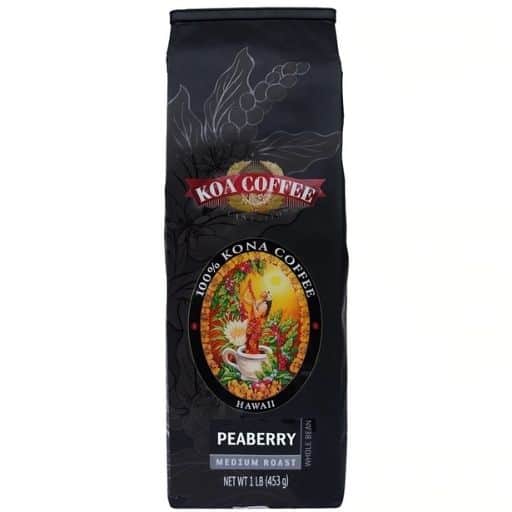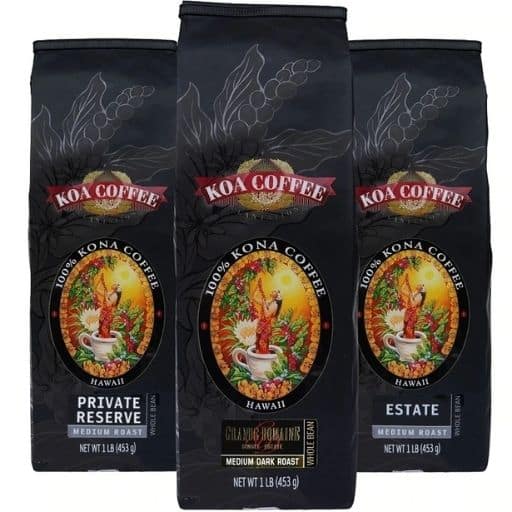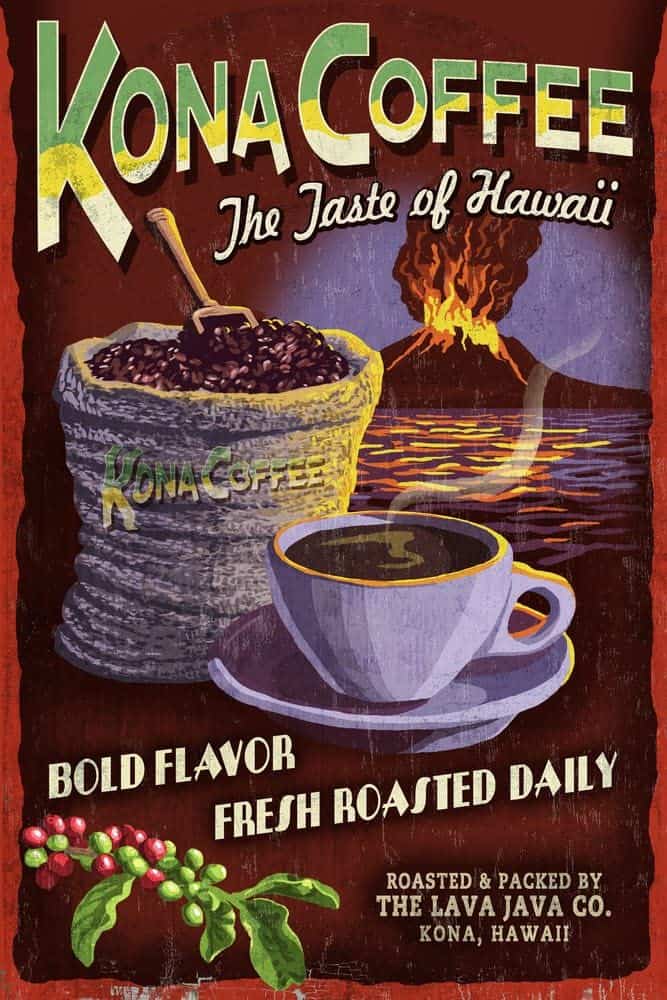fbq('trackCustom', 'view_shop_gear'); var trackEvent = 'shop_gear'; figure.wp-block-image.size-full.is-mobile-50p { box-shadow: none!important; } Ethiopia: where it all…
I remember how exciting it was when I was a kid and someone we knew went to Hawaii. They would bring back souvenirs of shells, chocolate-covered macadamia nuts, and pictures of plumeria blossoms. But the most coveted prize was the 100% percent Kona Coffee.
While times have changed, one thing remains the same. Real Kona coffees are still a highly prized brew. But now you don’t have to travel to Hawaii to get it! Through the miracle of online shopping, you can get these exquisite coffees delivered right to your door.
Read on to learn about the best Kona’s coffee and what makes it so special. We also offer some tips to help you avoid scams. Here’s to your next cuppa!

These beans are considered one of the best coffees in the world. It’s also a very rare coffee. It comes from the west side of the Big Island of Hawaii. This coffee-growing belt is only about 30 miles long and a mile wide.
By definition, coffee bags labeled 100% percent Kona is hand-picked from the slopes of the Hualalai and Mauna Loa volcanoes. Most Kona Coffee is the Typica varietal. The dark volcanic soil is the perfect growing condition for this type of bean.
The Kona region has about 600 small, independent coffee farms. They are almost all family-run. Most are between five and seven acres. Most beans undergo the wash process and are sun dried. The growers then machine hull the beans to get them to the green bean stage.
Hawaiian coffee has its own grading system. The state of Hawaii’s agriculture department created strict guidelines. The top five categories are Extra Fancy, Fancy, Number 1, Select, and Prime. This is based on the size and number of defects. I’ll never understand why Number 1 is not the best! Some of the Kona Coffee on this list have the highest, Extra Fancy, designation.
Is it the allure of a tropical paradise? Is it the fact that Hawaii is the only state in the US that grows Kona Beans? Is it the rarity of the bean? Or is it that the taste is exceptional?
You might ask 10 different people and get 10 different responses. Regardless of what makes Kona Beans so special, it is a fact that it’s one of the most sought-after coffees in the world.
Kona coffee is 100% arabica beans. Usually, arabica beans grow at high elevations. We’re talking at least 6,000 feet. Most lower-elevation arabica beans don’t make it into specialty coffee.
It may be surprising, then, that Kona Coffee is grown between 500 and 2,500 feet in elevation. It may be that high-altitude beans grow slower and flavor development needs slow growth. The growing conditions in Kona, cloud cover and rain, may be enough to slow the growth.
The rich volcanic soil also helps. The soil on these Hawaiian slopes is high in minerals and nutrients. It also provides good drainage. All these things combined to create perfect growing conditions in this small region.
The first thing you’ll notice about a true Kona brew is its sweet aroma. The specific scent may range from vanilla to berry to citrus, depending on which farm it came from.
One of the best things about Kona Coffee is its silky smoothness. It’s also low in acid and very easy to drink. It has a pleasant aftertaste that lingers.
The best Kona coffee is clean and well-balanced. It has a medium body, leaning toward the lighter end. If you like a full body like a Sumatran, this may not be the ideal coffee for you. But the rich aroma may reel you in, in spite of yourself.
Coffee lovers appreciate the delicate, fruity flavor. The brew sometimes has a spicy or buttery quality. Depending on the roast, it may develop nutty or caramel notes. It definitely has a richness that can be quite satisfying.
Now that you know a bit about this unique coffee, it’s time to try it. Here we rounded up five of the best Kona coffee brands we trust.

Koa Coffee started as a small family business in 1977. They focused exclusively on 100% Kona beans. Since then, it has branched out some to provide other Hawaiian varieties. Koa Coffee has won many awards and recognitions and is one of the best Kona Coffee brands on the market today. Forbes even named coffees from this company as one of the "Top 10 Coffees of the World" and "Best Coffee in America."
The coffee cherries for Koa Coffee are hand-picked. That means no bitter green cherries get mixed in. To maintain consistency, Koa Coffee cups every batch of roasted beans.
This product is 100% Kona Coffee peaberries. The peaberry is a mutation of the regular coffee cherry. Normally, the cherry forms two seeds that face each other. That's why one side is flat. With the peaberry, only a single, oval seed forms. Many believe that this packs more flavor into the single seed.
Kona's coffee is already rare, and the Kona peaberry is only about 4% of the Kona crop. As a result, the demand for this coffee far outweighs the supply. This particular offering from Koa Coffee is often sold out. Consider a subscription if you want to regularly drink this particular brew.
This Kona peaberry comes in a medium and a dark roast. We recommend the medium roast to preserve the unique character of the Kona beans. It is even smoother and sweeter than regular Kona. In the cup, this coffee is full-bodied with a rich flavor. A well-deserved spot on the best Kona coffee beans list.

We've already covered the merits of the Koa Coffee Company. They specialize in Kona's rich coffee, and they do it well and are considered to have one of the best kona coffee beans available to buy.
This Kona Coffee tri-pack includes three different coffees: Grande Domaine Kona, Private Reserve Kona, and Estate Kona. It's a great way to become familiar with various Kona beans. It's also ideal to give as a gift. And because it's a kona coffee three-pack, you save a little money in the deal, making it our best value selection.
The Grande Domaine Kona coffee has the distinction of winning a Coffee Cupping Contest for outstanding quality and balance. It comes in a Vienna roast, which is a light medium. This lighter roast maximizes the unique qualities of Kona's coffee. In the tri-pack, it comes in the whole bean. But you can also buy it separately as a pre-ground coffee.
The Private Reserve Kona won Forbes' "Best in America" title. It's an exclusive blend of 100% Kona coffee beans. In the tri-pack, it comes as a medium roast whole coffee beans. You can also buy it separately as a dark roast whole bean or a medium roast pre-ground.
Most Kona beans are grown at a lower elevation. But the Estate Kona is grown at a high elevation on the slopes of the Mauna Loa volcano. It is a single-estate coffee and offers a classic Kona experience. In the tri-pack, it comes as a medium roast whole bean. Like the Private Reserve, you can also get it as a dark roast whole bean or a medium roast pre-ground.

As the name implies, Volcanica focuses on coffees grown in rich volcanic soils. This also means that they mainly sell coffee grown at high altitudes. Volcanica only roasts to order, so you can be sure that your coffee will be as fresh as possible. The company provides high-quality coffee as well as excellent customer service and that's why they are on our best Kona coffee beans list.
Kona Extra Fancy is the best grade of Kona coffee beans and one of the best Kona coffee beans. The price tag may be steep, but you know you are getting the purest and best 100% Kona Coffee available.
All the beans for this coffee come from Aloha Farms. It is State of Hawaii Certified and Kosher Certified. The brew is lively, flavorful, and full-bodied with a floral-fruity taste. The beans are washed process and medium roasted. Flavor notes include jasmine, bright citrus, tart cherries, and caramel.
Every bag of this single-origin, shade-grown coffee comes in a premium blue velvet bag. This is a low-acid coffee with a pH of 5.2.

Here is another great coffee from Volcanica and also one of the best Kona coffee options on the market. This company roasts all their coffee beans to order right before shipping.
This offering also comes from Aloha Farms. But this only consists of the peaberries. Peaberries are a natural mutation when only one seed develops inside of the cherry instead of two. Coffee connoisseurs covet these oval beans for their deeper flavor.
The beans for this coffee are washed process and then sun-dried. This yields a brew that is smooth, nutty, and luscious. It is also low acid, with a pH of 5.2. Volcanica's Kona Peaberry coffee comes in a premium blue velvet bag.
Food and Wine Magazine rated this coffee as a "Top 10 Coffee" in March 2006. With strict quality controls, this coffee is just as delicious and satisfying today as it was then.

The Hawaii Coffee Company is a group of several coffee companies that banded together to serve a common goal. This group includes the popular Lion Coffee, which has been around since 1864.
Royal Kona Coffee got its start in 1969. The founders made a commitment to the Hawaiian coffee growers to buy 100% of their coffee crop. The coffee cherries are always picked by hand, leaving the green cherries on the plant to fully ripen.
The company has a coffee mill in Captain Cook, in the Kona region of the Big Island. You can even take a trip to Royal Kona's Visitor Center in Captain Cook! In addition to bags of 100% Kona beans, Royal Kona also has a 10% Kona blend coffee, flavored coffees, and decaf. You can buy the Estate Kona as whole bean or pre-ground.
Kona Estate comes from a single coffee plantation at a high elevation. This coffee is listed as a medium roast, but it is lighter than other medium roasts. The brew is bright and lively with a clean taste. A lighter roast preserves more of the delicate Kona flavor. But it has a little less body than other Kona coffee beans on this list.

You may be thinking, “I’ve tried Kona. It was no big deal.” But do you know if you had real 100% percent Kona Coffee?
Most of the coffee at the stores with a Kona label is a Kona blend coffee with as little as 10% actual Kona Coffee. The rest in these Kona blends comes from who knows where! Unethical marketers love to toss a little Kona into cheap coffee beans so they can jack up the price.
Use special caution if buying so-called Kona beans outside of the US. Businesses outside the US may not pay attention to the rules. Another scam is to include phrasing like “taste of Hawaii” or “Kona-style” beans which is just Kona blends but 100% percent Kona Coffee. Often, these have absolutely nothing in common with real authentic Kona Coffee beans. These are attempts to get more of your hard-earned cash.
If you want a true authentic Kona Coffee experience, don’t settle for anything less than 100% Kona Coffee beans. And make sure it actually comes from Hawaii.
The good news is that Hawaii has strict standards for the label of 100% Kona. The state has laws about it. The State of Hawaii Department of Agriculture and the Hawaii Coffee Association (HCA) banded together and secured federal trademarks for green coffee beans grown in Hawaii.
While Hawaiian Kona Coffee is the best Hawaiian coffee, Hawaii has several coffee-growing areas. The islands of Oahu, Kauai, Molokai, and Maui also have coffee farms. Each of these regions has a trademark logo that says where the coffee was grown. They also have a more generic 100% Hawaiian Coffee trademark logo.
The growing conditions in Hawaii outside of the Kona region are not ideal for coffee. While there may be some good coffee from these other areas, it’s more likely they’re using the Hawaii logo to charge more for mediocre coffee. In short, know that not all coffees with a 100% Hawaiian Coffee stamp are Hawaiian Kona coffee beans.

Hawaiian coffee farmers in the Kona region banded together to form the Kona Coffee Council (KCC). The group formed in 1985 to protect and promote the 100% Kona label. While the Department of Agriculture and the HCA certify green coffee beans, the Council certifies both green coffee and roasters. Look for the KCC Seal of Approval.
As we mentioned earlier, the state of Hawaii also has its own grading system. This system is not meant to replace the Specialty Coffee Association’s (SCA) point system. The SCA’s system is based on defects as well as cupping characteristics. This process is what entitles a coffee to call itself a specialty coffee. The SCA’s standards are applied to coffees grown anywhere in the world.
In contrast, Hawaii’s system assigns a grade based on the size, moisture content, and defects in a lot of beans. Flavor development is associated with bean size. These size categories help roasters ensure even roasting of the whole batch. The beans will also have a more even grind, preventing over- or under-extraction of the brew. The largest and best Hawaiian coffee beans are given the “Extra Fancy” grade.
Most of the Hawaiian coffees are Type 1. Hawaiian Peaberries are Type 2. Because these will necessarily be a different size than regular beans, they have a different grading system. The highest level of Hawaiian Peaberry is No. 1 Peaberry. The second highest is Peaberry Prime.

Coffee growing in Hawaii dates back to the early 1800s when it was brought back from Brazil. In 1828, Samuel Ruggles discovered that the plant did well on the volcanic slopes in the Kona region. By 1880, several plantations developed a healthy trade. Some of these still operate today. But sugar cane remained the dominant crop.
In 1892, Hermann Widemann brought a new variety of coffee plant to Hawaii. It was a Guatemalan variety. This plant is now called Kona Typica and is the preferred variety.
Coffee growers in Kona faced many ups and downs, and the whole industry nearly died out a few times. In the 1980s, specialty coffee was on the rise. New farmers brought life back into the Hawaiian coffee trade. Kona coffee’s position in the specialty coffee arena was cemented when Hawaii enacted laws to protect the Kona name.
We recommend any of the coffee brands on our list, but we do have favorites. Our overall top pick is Koa Coffee’s Peaberry Medium Roast Whole Bean 100% Kona. You can consider this the champagne of coffee beans. The Koa Coffee family takes great care in each step of the process. The result is a rich and flavorful brew to satisfy almost any coffee lover.
Our second ‘top pick’ is Volcanica’s Hawaiian Kona Extra Fancy Coffee. These larger beans pack in the flavor in a rich and smooth brew. Volcanica goes the extra step to assure that you’re getting 100% Kona beans from Hawaii. Rest assured that you will get what you pay for.
We mentioned in the reviews that Koa Coffee’s Medium Roast Whole Bean Kona Tri-Pack is a good value. But our best budget award goes to Royal Kona Estate Kona from the Hawaii Coffee Co. This single-estate coffee is grown a little higher up on the mountain. If you want to try a 100% Kona without breaking the bank, they offer a 7-ounce bag that can fit into any budget.
100% Kona Coffees are some of the most enjoyable brews you can get. Now you’re armed with the information you need to get the real thing. Let us know what you think!
Two things contribute to these coffee beans’ exorbitant price tag: rarity and production cost. To be called 100% Kona, it must be grown in a specific geographic area. When demand is greater than supply, the price goes up.
The other reason is the cost of production. Most coffees are grown in developing countries where labor is cheap. Fairtrade, Equal Exchange, and Direct Trade are certifications to let you know the workers picking and processing the berries are treated fairly. Because Kona beans are grown and processed in the U.S., the labor costs are many times what they are in other coffee-producing areas.
It really depends on personal preference. Many coffee lovers accept nothing less than pure Kona beans. When you buy 100% Kona, you know that the coffee cherries and beans have been handled carefully along the whole way. You also know that all the workers are paid real wages. The only way to know if Kona beans are worth the price is to try it for yourself.
Coffee grown in the Kona region is a low-acid coffee with a distinctly smooth and sweet taste. It comes from a small region on the slopes of the Hualalai and Mauna Loa volcanoes. Bottom line: if it’s not from this small district on the Big Island of Hawaii, then it is not real Kona beans.
